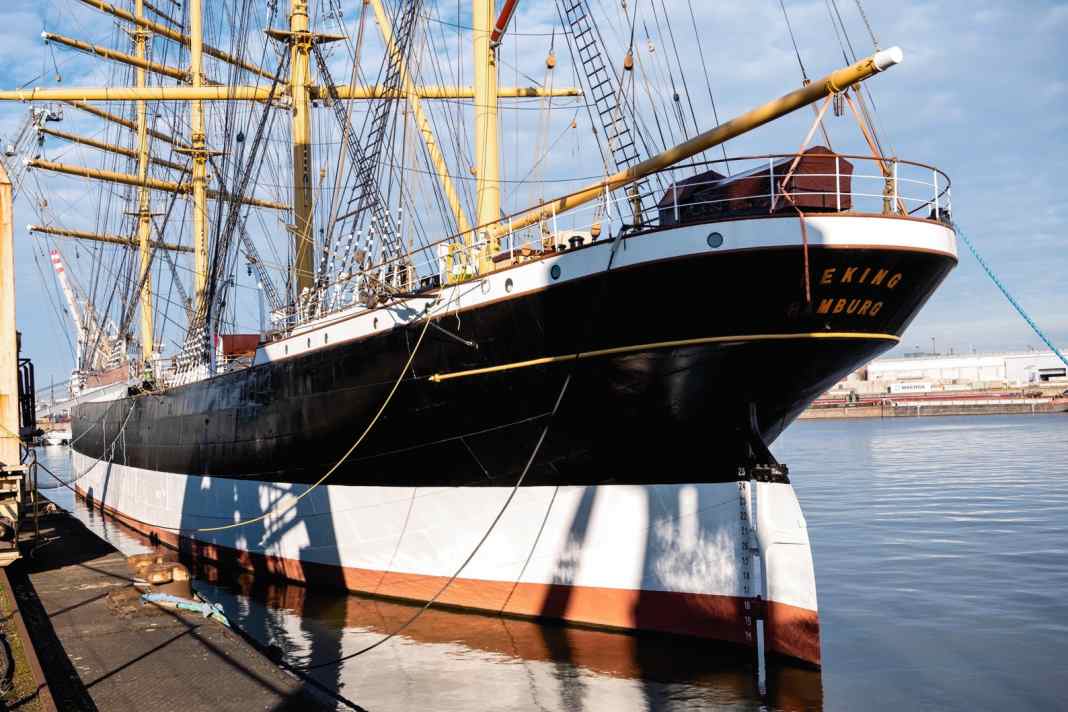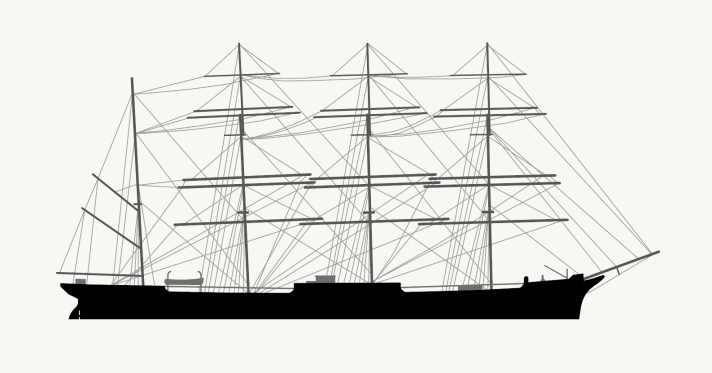





Hinrich Nissen was the name of the man who led the new "Peking" on its maiden voyage from Hamburg to Valparaiso in Chile in the summer of 1911. But the winter storms at the southern end of the world had little effect on the Cape Horn sailor, as the experienced captain was as legendary as the shipping company he served. He had been at sea for 40 years. And at F. Laeisz, he had already been entrusted with the largest ships, the five-masted barque "Potosi" and the five-masted full-rigged ship "Preußen".
Ships with the "P" in their name
Sailors like Nissen had made the Hamburg shipping company world-famous: their cargo ships were called Flying P-Liners because they were so fast and reliable. They were recognised by their names, which (almost) all began with P, such as "Plus", "Pisagua" or even "Peking". It all began in 1857 with the "Pudel" - the pet name of Sophie Christine, the curly-headed wife of company heir Carl Laeisz.
Perhaps it was the reputation of the Flying-P-Liners, perhaps it was their robust construction: in addition to the "Peking", three other of the steel four-masted barques with the "P" in their name have survived: "Passat" in Travemünde, "Pomerania" in Mariehamn on the Åland Islands and finally "Padua", which still sails today as "Krusenstern" under the Russian flag and was a frequent guest in German harbours until the invasion of Ukraine.
To South America for Chilean saltpetre
The "Peking" was therefore in a long line and, when it was commissioned, was one of the most modern sailing ships to be built, fully specialised in the lucrative saltpetre trade to South America. So-called Chilean saltpetre was found in large quantities in the Atacama Desert, which stretches between the Andes and the Pacific coast. At the turn of the 20th century, it was a sought-after raw material for fertilisers and explosives, as neither could be produced industrially at the time.
She was still completely reliant on the wind for propulsion - her two petrol engines only provided power for the on-board loading gear, the windlass and the existing radio system. In total, the "Peking" rounded the infamous Cape Horn 34 times under sail until her sailing time ended in 1932 - until the end under the flag of F. Laeisz.
"Peking" on the Medway and in Manhattan
The "Peking" was sold to England and spent the next 42 years as the "Arethusa" on the River Medway as a floating boarding school, followed by another 43 years as the highlight of the South Street Seaport Museum in Lower Manhattan, but there was no money for an urgently needed comprehensive refurbishment in 2017, when she finally returned home to Hamburg - piggybacked on board a dock ship.
The new owner was the Hamburg Maritim Foundation. Over the following three years, the veteran was restored to her original condition at a cost of almost 40 million euros, including a long period in dry dock. She has been shining in her former glory again since 2020. However, she will swap her current berth a little off the Elbe for a new home directly on the river when the new German Harbour Museum on Kleiner Grasbrook is completed in a few years' time. The "Peking" will then be both an eye-catcher and a highlight.

Technical data of the "Peking" (1911)
- Four-masted barque, cargo sailing ship
- Shipyard: Blohm+Voss, Hamburg
- Hull material: steel
- Length (over all): 115 m
- Height (main mast): 53.1 m
- Sail area: 4,100 m2
- Speed (sail): 17 kn
- Berth: Hansahafen, Hamburg
Information for visitors
"De Hamborger Veermaster", the figurehead of the German Harbour Museumis located on Bremer Kai in front of the 50er sheds. When the second location is completed, it will move to Kleiner Grasbrook. The guided themed tours are "construction site tours" and are not barrier-free.
Opening hours: The tours must be booked online. April to October Mon, Wed-Fri from 10 am to 3 pm and on weekends and public holidays from 10 am to 4 pm.
Prices: 15 euros, children under 18 free of charge. But: Participation only from 1.20 metres! The price includes admission to the harbour museum. Tel.: 040/428137130
Journey: The launch of the Maritime Circle Line departs from jetty 10 in the direction of the harbour museum. Timetable and prices on the Internet. Alternatively: HADAG ferry 73 to Argentinienbrücke, then bus route 256.

